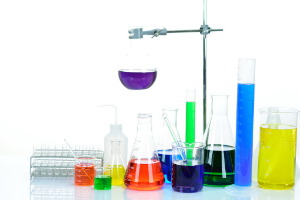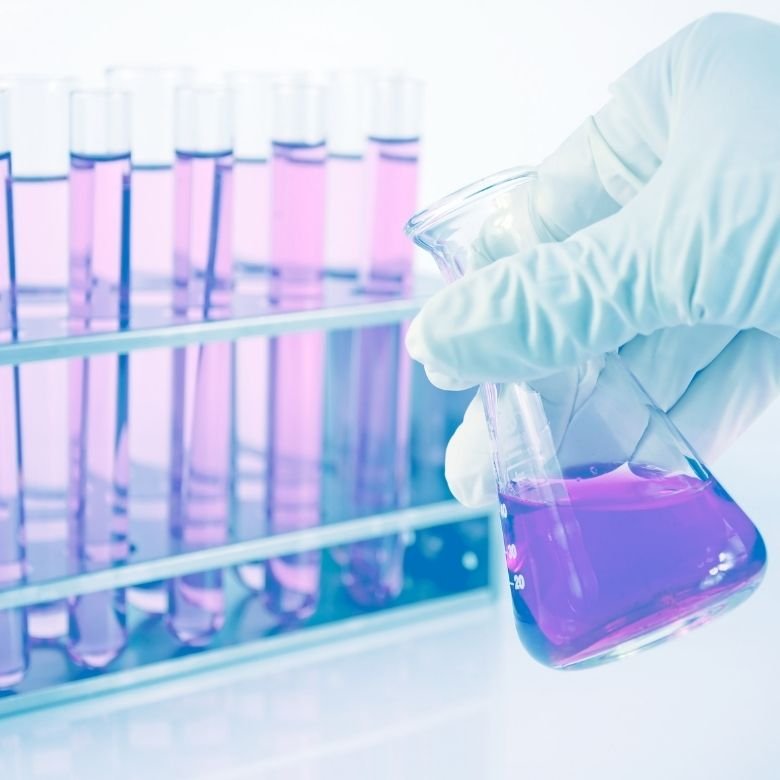Analysis, synthesis, content determination and many other key tests could not take place without specialised chemical reagents, which is why you find a lot of them in any chemical laboratory. How do we classify chemical reagents? How do they differ and where are they used? You can read all about them in the article below.

Virtually every laboratory uses a range of chemical reagents. These include, for example, indicators, standards, hydroxides, acids, salts, alcohols and solvents and buffer solutions.
Key features
Chemical reagents are characterised by fixed quality parameters (taking into account the level of impurities and the content of the main ingredient), a defined shelf life and appropriate packaging to guarantee an unchanging composition.
One of the most important parameters is the purity of the chemical reagents. We define this as the percentage by weight of the main substance which does not include the impurities present. The main substance in chemical reagents is usually a single compound, but they also occur as mixtures of several substances.
Reagents are available both as liquids (solutions of defined concentrations) and solids (powders, granules, lozenges). Depending on the intended use, reagents are available with varying properties and qualities.
Classification of chemical reagents
Chemical reagents are usually classified according to their purity. Not all chemical analyses require the highest quality and purity. Therefore reagents are divided into several purity classes. These define the content of the main substances as well as the permissible levels of impurities.
Among the chemical reagents we can distinguish:
- chemically pure reagents (ch.pr.) – content of the main substance in the range 99.99-99.999%. These are top quality reagents, designed to meet the requirements for specialised laboratory techniques. The amount of impurities is below the detection limit of chemical methods.
- pure reagents for analyses (prfa.) – content of the main substance in the range 99.9-99.99%. These are used in laboratories to perform quantitative and qualitative analyses in accordance with norms.
- spectrally pure reagents (spectr.pr.) – content of the main substance in the range 99.999-99.9999%. These are used for spectral analyses, e.g. HPLC, GC.
- pure reagents (pr.) – content of the main substance in the range 99-99.9%. These have stable quality parameters. They are used in standard laboratory work, usually for qualitative analyses. They can be used as substrates for syntheses and auxiliary substances.
- technical reagents (techn.) – content of the main substance in the range 90-99%. Usually products of industrial syntheses.
Some chemical reagents are additionally labelled with the FP symbol. Such substances are characterised by extremely high purity. They meet very strict pharmacopoeial requirements and are used for pharmaceutical analyses. A similar marking is the PhEur symbol. This symbol confirms that the selected reagent meets the requirements of the European Pharmacopoeia, which means that it can be used for laboratory analyses of medicines in European countries.
Among chemical reagents is also the group of analytical reagents. These are divided into: group, selective, specific and masking reagents. The classification depends on their application.

Application of chemical reagents
Chemical reagents are most often used in various types of research work, chemical analysis, in the preparation and also the production of other substances. The characteristics of laboratory applications and their scale determine the quantities and types of reagents. These substances are used for such analyses as: ion determination, separation of cation or anion mixtures, detection of specific ions and many others.
The PCC Group’s range of chemical reagents
The PCC Group’s products include a wide range of high quality chemicals, which are used as chemical reagents. They are produced in the standard of integrated quality management system according to ISO 9001, ISO 14001, ISO 50001, BS OHSAS 18001.
These include pure chlorobenzene, flaked caustic soda and pure hydrochloric acid min. 37%. These substances are used respectively in quantitative research, qualitative analysis and instrumental analysis. The excellent product parameters allow their use in the most demanding laboratory analyses. The chemical reagents we offer are also marked with the UltraPure label, which guarantees the purity and highest quality of the products.
- IUPAC Compendium of Chemical Terminology, 3rd ed. International Union of Pure and Applied Chemistry; 2006. Online version 3.0.1, 2019
- https://www.reagent.co.uk/blog/different-types-of-chemical-reagents-and-uses/
- Budavari, Susan, ed. (1996), The Merck Index: An Encyclopedia of Chemicals, Drugs, and Biologicals (12th ed.), Merck
- https://www.spectrumchemical.com/chemical/analytical-chemistry-reagents